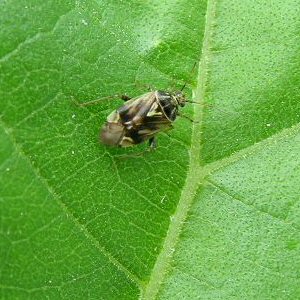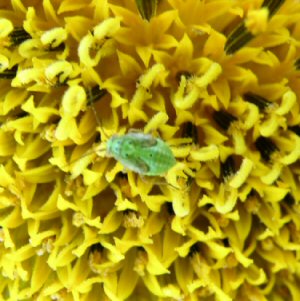Lygus Bug On Sunflowers
Lygus Bug Feeding by lygus bugs on developing sunflower seeds can cause small brown to black spots on the seeds, known as kernel brown spot. Typically a kernel will have only one spot, on the blunt or distal end.

Figure 1 Lygus adult

Figure 2 Lygus nymph
Host Crops
Lygus bugs have been recorded from over 385 crop plants and weeds.
Biology
Adult lygus bugs (Figure 1) are about 5 mm (0.2 in) long and 2.5 mm (0.1 in) wide. They vary in color from pale green to reddish-brown and have a distinct triangle or “V” mark about one-third of the distance down the back, just in front of the wings. First stage nymphs are very small, wingless and bright green. Nymphs (Figure 2) may look similar to aphids but are much more mobile. Lygus bugs feed on plants by injecting plant tissue with digestive enzymes, and then extracting nutrients with their needle-like mouthparts. Lygus bugs feeding on developing sunflower seeds can cause scarring on the seeds, known as kernel brown spot. While brown spot is not known to affect yield, this quality issue can be significant in confection sunflowers because processors are allowed only 0.5% damage in the finished product. Lygus bug feeding can also result in a bitter taste to the seeds. While brown spot is visible on dehulled kernels, there is usually no sign on the exterior of the hull that the kernel has brown spot. Lygus bugs are mobile and can be found on many crops. Lygus bugs probably move to sunflowers from alfalfa or canola when those crops have either been harvested or senesced.
Scouting Techniques
Scout for adults or nymphs on the sunflower heads or foliage.
Economic Thresholds
Lygus bugs are capable of damaging 30 to 35 seeds per head per adult. With the industry standard allowing for a maximum of 0.5% kernel brown spot, the economic threshold for lygus bugs on sunflowers is likely about one lygus bug per nine heads. In research trials, damage to sunflower heads was approximately twice as severe when infestations occurred at late bud and early bloom compared to stages when heads had completed flowering. Thus, lygus bug management should be initiated prior to or at the beginning of the bloom stage if adult densities approach the economic threshold. Also, fields should be monitored for lygus bugs until flowering is completed to reduce incidence of kernel brown spot damage to confection sunflowers.

